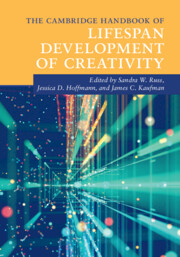Book contents
- The Cambridge Handbook of Lifespan Development of Creativity
- The Cambridge Handbook of Lifespan Development of Creativity
- Copyright page
- Dedication
- Contents
- Figures
- Tables
- Contributors
- Acknowledgments
- Introduction
- Part I Core Concepts of Lifespan Creativity Development
- Part II The Development of Creativity
- Part III Modes of Enhancement
- 12 Domain-Specific Talent Development
- 13 Enhancement of Creativity across the Lifespan in Mainland China
- 14 Beyond Flights of Fancy?
- 15 Creating Imaginary Worlds across the Lifespan
- 16 Imaginative Creativity in the Writing and Reading of Stories
- 17 The Effects of Video Games on Creativity
- Part IV Environments and Contexts
- Part V Special Populations
- Index
- References
15 - Creating Imaginary Worlds across the Lifespan
from Part III - Modes of Enhancement
Published online by Cambridge University Press: 19 November 2021
- The Cambridge Handbook of Lifespan Development of Creativity
- The Cambridge Handbook of Lifespan Development of Creativity
- Copyright page
- Dedication
- Contents
- Figures
- Tables
- Contributors
- Acknowledgments
- Introduction
- Part I Core Concepts of Lifespan Creativity Development
- Part II The Development of Creativity
- Part III Modes of Enhancement
- 12 Domain-Specific Talent Development
- 13 Enhancement of Creativity across the Lifespan in Mainland China
- 14 Beyond Flights of Fancy?
- 15 Creating Imaginary Worlds across the Lifespan
- 16 Imaginative Creativity in the Writing and Reading of Stories
- 17 The Effects of Video Games on Creativity
- Part IV Environments and Contexts
- Part V Special Populations
- Index
- References
Summary
The invention of imaginary worlds may be understood as a powerful tool for exploring experience, discovering the self, and creating knowledge and meaning. An imagined world is an earth or universe or a system of make-believe ideas and things that may be contemplated in the mind, though it remains veritably unexperienced. In childhood, worldplay (paracosm play) refers to imaginative pretense that is persistent, cumulative, and constructive (maps, stories, drawings, and more may be generated). In adulthood, worldplay refers to the world-building narratives of writers and artists; to the plausible reconstructions, scenarios, and probable worlds of social scientists; and to the theoretical suppositions and possible worlds of scientists. As such, worldplay presents a unique opportunity to probe what-if cognition. Indeed, as the history of its study indicates, world invention as play and as creative strategy tells us much about development of imaginative thinking and the growth of creative competence across the lifespan.
Keywords
- Type
- Chapter
- Information
- The Cambridge Handbook of Lifespan Development of Creativity , pp. 327 - 350Publisher: Cambridge University PressPrint publication year: 2021
References
- 1
- Cited by

